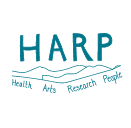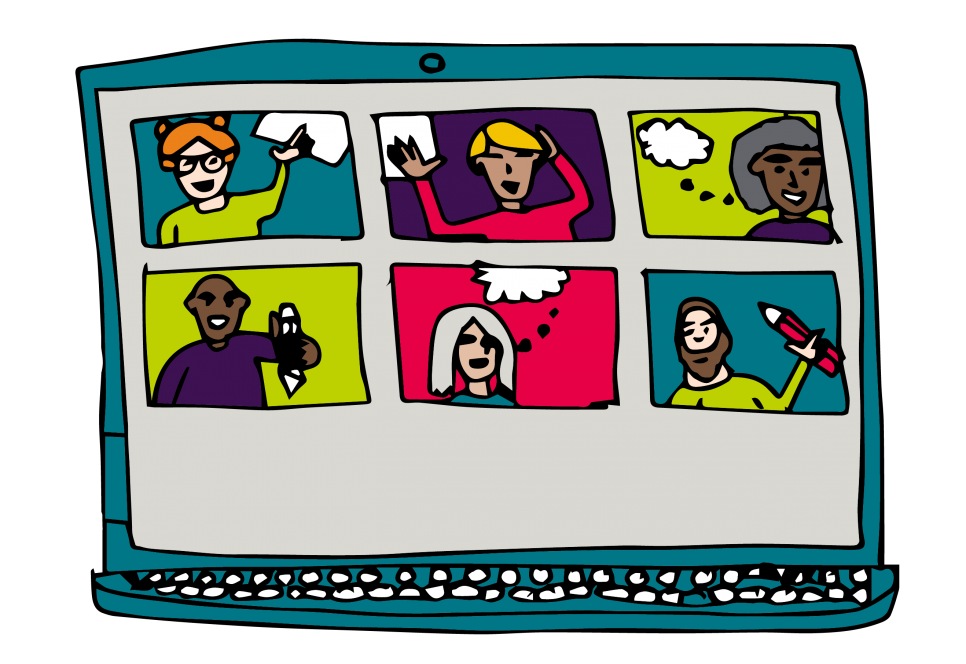Jonny Cotsen, freelance performing artist and access consultant; Sarah Goodey, arts development manager, Gwent Arts in Health and Aneurin Bevan University Health Board; and Louise Hobson, independent producer and curator.
The aim: To platform the voices of D/deaf, disabled and neurodivergent people during the pandemic - a time which has magnified inequalities for disabled people - and, by sharing their works with health and arts institutions, prompt positive change during this time of reimagining, reopening and rebuilding.
The activity: Commissioning six D/deaf, disabled and neurodivergent artists to create works reflecting on their experiences of the pandemic and hopes for the future.
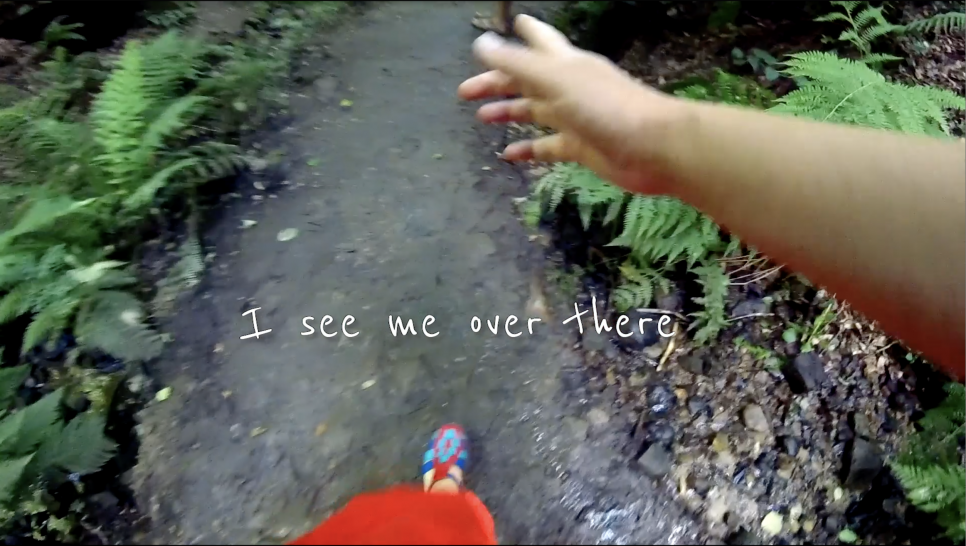
What need were you seeing in the world that motivated you to embark on the HARP Sprint challenge?
Sarah: From my perspective in arts and health within the NHS, I was happy to see how agile our workforce - both in health and arts - could be when compromised, and I was interested in seeing how we could acknowledge, capture and continue new practices.
Jonny: The moment when we were told theatres were going to close, I felt as a disabled artist “how can I deal with it?”. It was happening too quickly for me and I didn't have time to think, breathe or really understand how I could progress as an artist; I was in a confused state of mind. I thought a lot about the barriers I was going to face - more barriers! I felt that I needed to think about my well-being and my own art practice.
Louise: My experiences are primarily within the visual arts and when so much that had previously been set in stone was closed, cancelled or postponed and suddenly shifted to online / remote programmes: what had been presented as impossible to do or redirect, happened overnight. In Bruno Latour’s What protective measures can you think of so we don’t go back to the pre-crisis production model? we are invited to consider together ‘what we are attached to; what we are ready to give up; the chains we are ready to reconstruct and those that, in our behaviour, we have decided to interrupt?’
What did you want your contribution to be? What were your goals, hopes and dreams for your participants?
As a team, we have been centering people who are D/deaf, neurodivergent and disabled. We were collectively experienced in event based activities, performance and curating, and we recognised that our response would be strongest if we played to our strengths.
We wanted to reflect on the question: Why were we rushing back to ‘normal’ when normal doesn't work for so many people? And to commission artists to create new works which offer points of reflection for arts and health organisations to learn. In Normate Template: Knowing-Making the Architectural Inhabitant Aimi Hamraie writes: “Examine any doorway, window, toilet, chair or desk…and you will find the outline of the body meant to use it”. We began to think about that outline of a ‘normative template’ and how this very specific moment offers an opportunity to reimagine and support the call that D/deaf, neurodivergent and disabled people are on that centre stage as we rebuild our post-pandemic world.
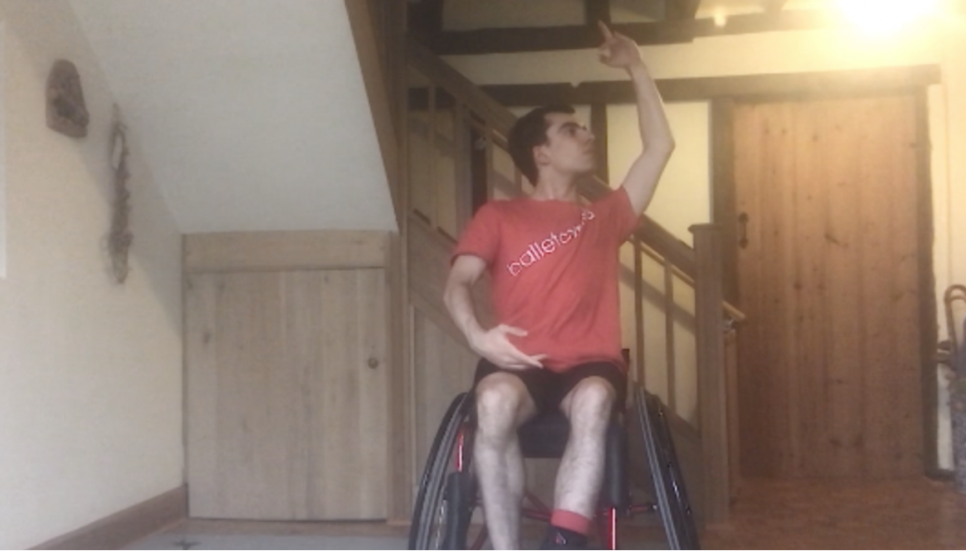
So our goals were to:
- Use creativity and art to platform and uplift the voices of marginalised groups so that they/we can positively contribute to ongoing social change for D/deaf and or disabled and neurodivergent people within the context of arts and health through artist commissioning.
- Tell a story to encourage understanding - create a space for artists to make works responding to personal reflections on this very moment and hopes (and fears) for our future.
- Creatively reflect on resources, systems (what works and what doesn’t) and capacity building - advocating to arts and health professionals / bodies / organisations towards unlocking best practice for the future for D/deaf,disabled and neurodivergent artists and audiences.
“Before COVID my focus was around conversations and that was taken away from me because of the communications barriers. Somehow I got that back by having those conversations [with Louise and Sarah] as there is a sense of trust and openness. We really wanted to, from our learnings, reflect with our artists. There were some really beautiful conversations and as a personal view, I almost needed it or we all needed it” - Jonny Cotsen
What did you do and why?
We followed an open call process and appointed six artists, for whom we built a website to showcase their work - imagining it like a group exhibition. We met with all of the artists remotely and where possible introduced them to each other so we could talk about the process of making the work and gather learning from them and each other. We organised BSL, transcripts and audio description where possible; we thought a lot about the language and accessibility of the works, to reach out to a wider audience.
We have just launched the website (www.conversationsfutureselves.co.uk) . We hope this space becomes a creative resource for those working in the arts and/or health sectors in Wales - encouraging professionals in these spaces to spend time with the artworks and reflect on what’s being shared and how they might think about the role they play in upholding working practices which benefit some over others.
There was a brilliant response to the open call. Time and budget constraints made it unfortunate that we couldn’t make everything accessible. However Jonny did have conversations with the artists about access and what felt right for them and their work, and we accommodated that.
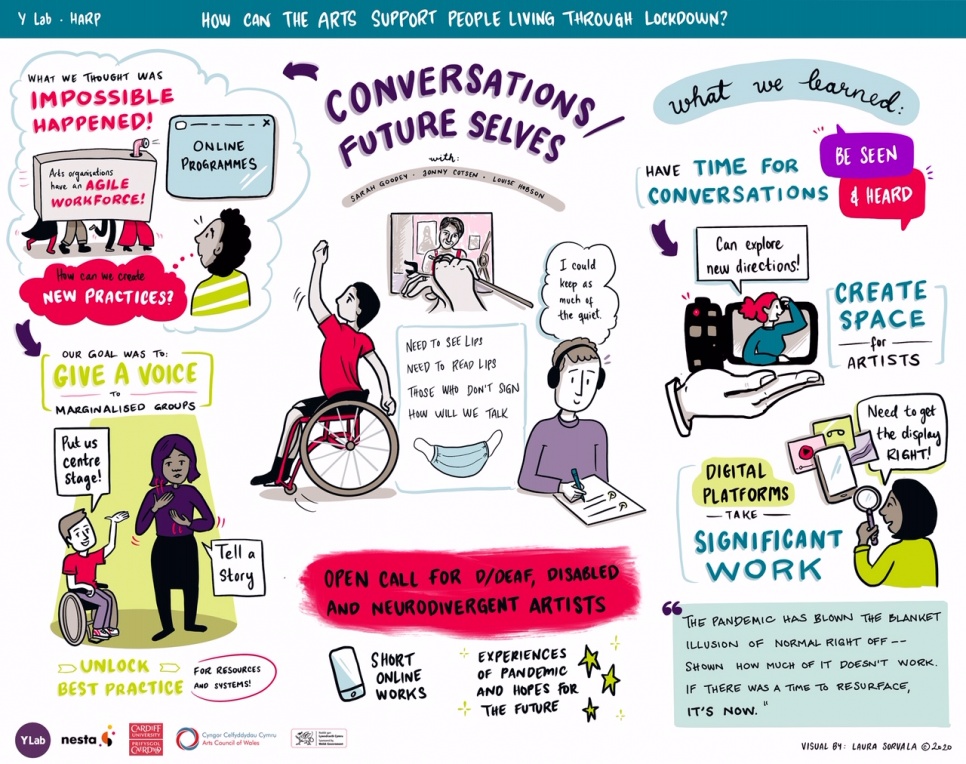
What are your learning points about the artform/s you chose and how people engaged with it?
We did not prescribe an artform but the platform could only be digital - this has meant a significant amount of work to build a website and display content appropriately. Through commissioning artists, we’ve worked across artforms, supporting artists making work across dance, music, spoken word, painting and video. We’ve engaged with the six artists and as of 10 September, we’ve had 653 unique visitors to our website and counting. 176 of those visited on 31 July, when we launched the website.
It was so important to have conversations with the artists about the work they were going to make and find the time so that they could talk together too.
In the context of our project, we’ve been thinking about wellbeing in the long term and looking at this particular moment as a catalyst for change. In creating a space for artists to be listened to and supported to create new work, which reflects on the time we’re in and what their hopes and fears are for the future, we hope that this project enables other people to feel seen and heard.
What have participants got from this activity?
Through conversations with artists, we learned that making these works has often reinforced or changed their practice. Some have said it's given them an opportunity to try a different direction which they now want to explore afterwards, or to work in a new media for the final piece - e.g video. The domestic setting has also shone a light on disability at home, which is not necessarily always visible, as a source of creative inspiration and practice for the artists.
In this project the participants are
- the artists we’ve commissioned; and
- those who visit the Conversations / Future Selves website, specifically those working in arts and health in Wales.
To reflect on what participants have got from this activity, here is a brief excerpt from artist Sophia McLean’s monologue, which draws attention to how a seemingly small detail - like the slight slope of a pavement - can create a daily obstacle to overcome. There are so many obstacles and for those who visit the Conversations / Future Selves website and experience these artworks, our hope is that they think about the obstacles they have the power to remove or redirect around, especially for those who are D/deaf, neurodivergent and disabled. Here’s an excerpt from Sophia’s monologue:
“When I wake up in the morning, I won’t know whether I’ll have paralysis from the waist down, or the energy to push a wheelchair down the street. It’s a tiny thing, but if you look closely, all pavements are slightly sloped to drain rain water effectively. But to navigate a wheelchair on, is like going on a slalom with one ski dipped in treacle, and if you lose grip, free-diving into traffic.
Those roads weren’t built with us in mind. And if I want to go out to be a Tesco toilet-paper bandit, I’ve got to think twice if I have the energy to get there.
And that extends to society. Many things were not built with all in mind.
The pandemic has blown the blanket illusion of normal right off and illuminated many of the disparities, separations, inequalities in our society and shown how much it doesn’t work. If there was any time to resurface, relevel and change it is now.” Sophia McLean, artist
Where will the team go from here?
They will continue sharing the website with health networks and gathering feedback. In terms of how they will build on this experience, the team have said:
Sarah: I will take forward three things. First, that remote team working is possible and can be both creative and productive. Second, I now have a much greater awareness of the experiences and needs of D/deaf, disabled and neurodivergent people. Third, that I intend to engage colleagues in the health board and third sector staff in discussions about how we can better address the needs described and expressed by the artists that we worked with.
Jonny: I will teach / educate others and challenge myself and others in new spaces (online and physical). I particularly enjoyed the commissioning process, as it was very satisfying to be supporting other artists to make work that told their own stories.
Louise: When imagining future research and projects, I’m now thinking about how to rethink my position from independent to interdependent. To work both ‘in’ and ‘on’ institutions, to ensure there is time to listen and support holding space for others.
Financial details
The direct total cost of the Conversations / Future Selves project was around £2,000, including the six artist commissions, the website and providing access support for artists.
Louise, Jonny and Gwent Arts in Health each received a grant from Y Lab of £1,000 each to participate in the HARP Sprint.
This was originally published on Y Lab’s website in this format.
